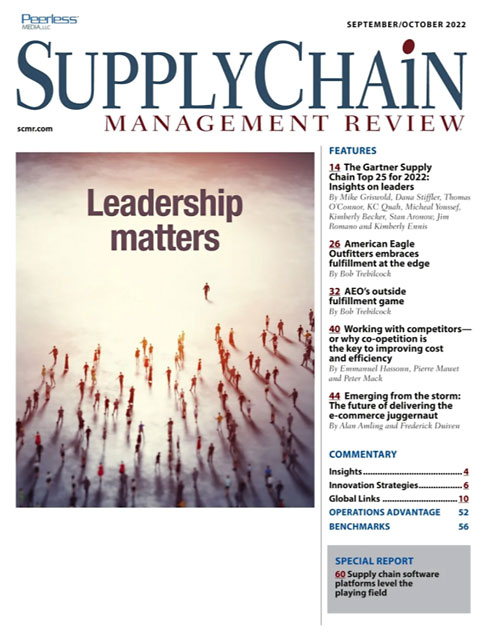Sorry, but your login has failed. Please recheck your login information and resubmit. If your subscription has expired, renew here.
September-October 2022
Once again, it’s time for Gartner’s Top 25 supply chains, the annual list of the 25 supply chains that have made it to the top, plus five Masters that have consistently outperformed year after year. You can read the article, along with some web-only material on scmr.com, to find out what it takes to become a supply chain leader. Last year, I was struck by how the leaders were embracing ESG, or Environmental, Social, & Governance. That has only been reinforced in this year’s report. In fact, ESG has been on the agenda of every event I’ve attended this year, including the keynote address at this year’s ISM conference. Whatever is the… Browse this issue archive.Need Help? Contact customer service 847-559-7581 More options
During a recent visit to a large defense company, we commended the CEO because a half dozen of the company’s operating units were led by women. A noteworthy achievement to be sure, but isn’t it far more remarkable that such senior gender balance remains a stark exception in operations?
Despite the case for diversity being generally acknowledged, with companies expressing strong commitment to improving diversity, progress for women in operations remains slow, incremental and very uneven.
For decades now, there’s been a societal drive to counter the unconscious bias that so often steers women and girls away from STEM education and career paths. Though much work remains to be done, there has clearly been improvement, demonstrating that gender inequality in these educational fields can be addressed. The push for gender balance in STEM education should continue to increase the number of women in operations, as many of these roles require engineering degrees. Unfortunately, the progress being made in attracting women and girls to STEM fields is still frequently undone at the company level, after women enter the workforce.
Women in the new era of work
A wealth of anecdotal evidence to this effect emerged when Kearney hosted an International Women’s Day Forum last March 8, in partnership with Stanley Black & Decker (SBD) and UPS. A highlight was a panel titled “Women in the New Era of Work,” involving senior women leaders from across industries, including Paula Northern, vice president of global supply chain for Cloud operations and innovation at Microsoft; Liz Markus, head of the global talent management partnership group at Johnson & Johnson; Rocki Howard, chief people and equity officer at The Mom Project; and Sonita Lontoh, a public company board director and Fortune 100 executive, most recently as Global Marketing Head at HP. Themes this panel explored are as follows.

This complete article is available to subscribers only.
Log in now for full access or start your PLUS+ subscription for instant access.
SC
MR
Sorry, but your login has failed. Please recheck your login information and resubmit. If your subscription has expired, renew here.
September-October 2022
Once again, it’s time for Gartner’s Top 25 supply chains, the annual list of the 25 supply chains that have made it to the top, plus five Masters that have consistently outperformed year after year. You can read… Browse this issue archive. Access your online digital edition. Download a PDF file of the September-October 2022 issue.During a recent visit to a large defense company, we commended the CEO because a half dozen of the company’s operating units were led by women. A noteworthy achievement to be sure, but isn’t it far more remarkable that such senior gender balance remains a stark exception in operations?
Despite the case for diversity being generally acknowledged, with companies expressing strong commitment to improving diversity, progress for women in operations remains slow, incremental and very uneven.
For decades now, there’s been a societal drive to counter the unconscious bias that so often steers women and girls away from STEM education and career paths. Though much work remains to be done, there has clearly been improvement, demonstrating that gender inequality in these educational fields can be addressed. The push for gender balance in STEM education should continue to increase the number of women in operations, as many of these roles require engineering degrees. Unfortunately, the progress being made in attracting women and girls to STEM fields is still frequently undone at the company level, after women enter the workforce.
Women in the new era of work
A wealth of anecdotal evidence to this effect emerged when Kearney hosted an International Women’s Day Forum last March 8, in partnership with Stanley Black & Decker (SBD) and UPS. A highlight was a panel titled “Women in the New Era of Work,” involving senior women leaders from across industries, including Paula Northern, vice president of global supply chain for Cloud operations and innovation at Microsoft; Liz Markus, head of the global talent management partnership group at Johnson & Johnson; Rocki Howard, chief people and equity officer at The Mom Project; and Sonita Lontoh, a public company board director and Fortune 100 executive, most recently as Global Marketing Head at HP. Themes this panel explored are as follows.
SC
MR


Latest Supply Chain News
- Made in Mexico, manufactured by China
- Retail sales see gains in October, reports Commerce and NRF
- Balancing green and speed: Home delivery insights from the pandemic era
- AdventHealth named top healthcare supply chain by Gartner
- Geopolitical readiness in supply chains: Strategic challenges for leaders
- More News
Latest Podcast

 Explore
Explore
Business Management News
- Made in Mexico, manufactured by China
- Retail sales see gains in October, reports Commerce and NRF
- Balancing green and speed: Home delivery insights from the pandemic era
- AdventHealth named top healthcare supply chain by Gartner
- Unlocking retention: The role employee engagement plays
- Can supply chain managers embrace an entrepreneurial mindset?
- More Business Management
Latest Business Management Resources

Subscribe

Supply Chain Management Review delivers the best industry content.

Editors’ Picks





